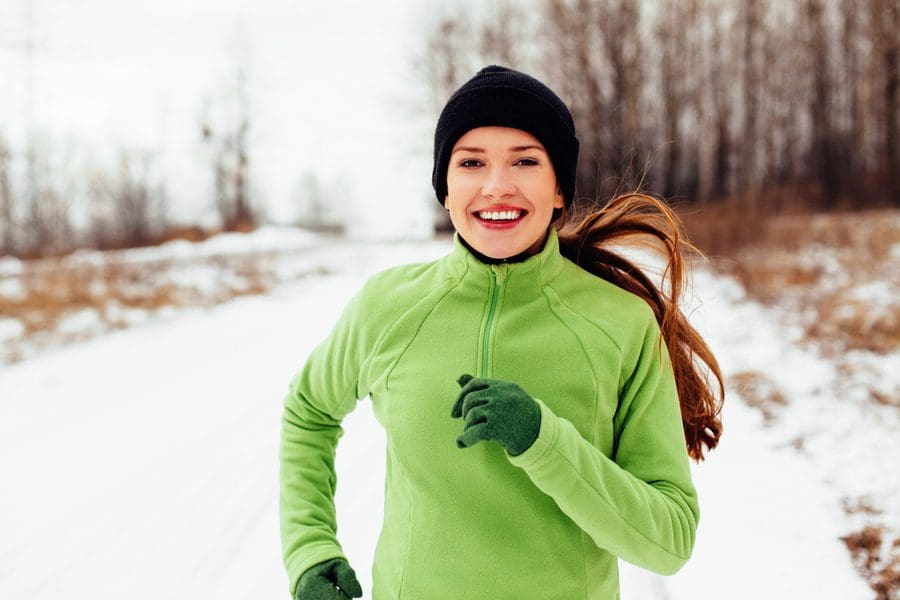Exercise outdoors in winter’s cold weather can lift your spirits and boost your energy during dark, dreary days, but you’ll need to take extra precautions to stay safe and warm. Chilly rain and snowy days don’t have to discourage you from your workout. Add extra insulation, apply sunscreen, stay hydrated and you won’t lose a valuable minute. If you need a little more motivation, think how outdoor exercise will keep holiday weight gain at bay. Check out these tips for exercising outdoors in cold weather.
Wear bright colors
Skies are darker in winter and it’s difficult for motorists and other athletes on the trail to see you. Wear brightly colored clothing and gear for outdoor exercise. Add reflective gear or blinking lights. Wearable flashlights will light your way and help prevent you from making missteps and falls.
Dress to stay dry
Exercising when you’re wet and cold will make for a miserable (and predictably shorter) workout. Hypothermia can drop your core body temperature below 95 degrees Fahrenheit and put you at risk. This medical emergency means your heart, nervous system and other organs can’t work normally and if left untreated can eventually lead to death. In freezing conditions, you might suffer frostbite.
Avoid hypothermia by keeping wet fabric away from your skin. Opt for active wear made from synthetic fibers instead of cotton. Look for garments of polyester, nylon and polypropylene. They’re designed to pull moisture away from your skin quickly (about 50 percent faster than cotton).
Dress in layers
Layers will hold warm air next to your body and keep out wind, rain and snow. First put on a thin base layer made of synthetic fabrics to help wick away moisture. Cotton soaks up sweat and rain and holds in moisture. Add a middle layer to add extra warmth if it’s really cold. Polar fleece is a good choice for the middle layer.
Finish with an outer layer or shell for protection against rain, snow and wind. When you’re shopping for the outer layer, keep in mind that the more water-repellant versions allow less sweat to escape from inside.
Save your skin
The humidity that can make your summer run a sweaty mess disappears in winter. Now the air is dry as well as cold. Protect your skin from drying out by drinking about eight 8-oz. glasses of water each day. Use moisturizing cream or lotion, and protect sensitive areas such as ears, nostrils and tip of the nose by applying Vaseline. If the wind is brutal, cover your face with a scarf or running mask.
Sunburn is a real thing in winter as well as summer. If you’re skiing or snowboarding in the mountains, your risk of sunburn is even higher, as snow reflects up to 80 percent of UV rays. Wear sunscreen with at least SPF 30 and apply SPF lip balm before your workout and keep on applying. Wear UV-blocking sunglasses to protect your eyes.
Protect fingers and toes
Cold temperatures send blood to the core of the body away from your fingers, ears, nose, and toes. Protect extremities from freezing and wear a hat or headband, gloves or mittens, and socks. These should be made of wool or synthetic material instead of cotton. Running shoes that are designed to let heat escape will also allow cold to seep in. Try shoe covers that can be found at a skiing or hiking store or look for shoes designed to withstand the cold at a specialty running store.
Shed layers as you warm up
Start taking layers off as you warm up to your baseline temp. Start with removing gloves or your beanie and go from there.
Cool down and remove damp clothes
A cool-down eases potential muscle soreness, rids your body of exercise by-products and helps your heart. Standing around after strenuous exercise creates stress for your heart. Gradually taper off your exercise during the last 5 to 10 minutes of your cold-weather workout. When your breathing and heart rate return to normal, repeat your warm-up stretching.






